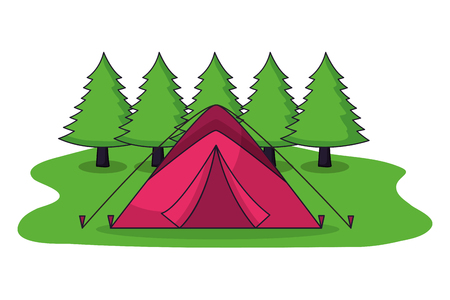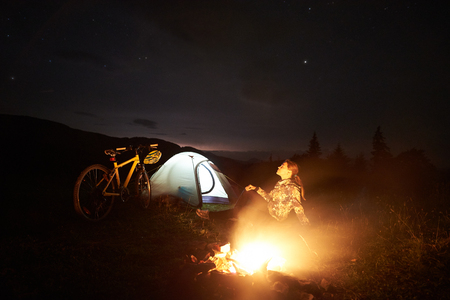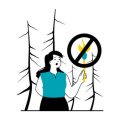1. Understanding the Basics: Map Types and Compass Features
If youre planning to head out into the wild, knowing how to use a map and compass can be a lifesaver—literally. GPS devices are great, but batteries die and signals drop. Thats why every camper should master traditional navigation tools. Lets start by getting familiar with the basics of topographic maps and the key parts of a compass.
Topographic Maps: What You Need to Know
Topographic maps (often called “topo maps”) show not only roads and trails but also land features like hills, valleys, rivers, and forests. They use contour lines to represent elevation and terrain shape.
Key Elements of a Topographic Map
| Element | Description |
|---|---|
| Contour Lines | These lines connect points of equal elevation. The closer the lines are, the steeper the terrain. |
| Scale | This tells you the ratio between distances on the map and actual ground distances. For example, a 1:24,000 scale means one inch equals 2,000 feet in real life. |
| Legend | The legend explains symbols used on the map—like campsites, water sources, trails, and roads. |
| Northern Indicators | This shows the direction of true north, magnetic north, and grid north. Understanding this is key for accurate navigation. |
The Compass: Your Directional Guide
A good compass is more than just a spinning needle. It has several parts that help you find your way when paired with a topo map.
Main Parts of a Compass
| Part | Description |
|---|---|
| Baseplate | The flat part you hold; often includes rulers for measuring distance on maps. |
| Damping Needle | The magnetized needle that always points toward magnetic north. |
| Rotating Bezel (Housing) | The circular dial marked with degrees from 0° to 360°. You turn this to set your direction. |
| Orienting Arrow & Lines | This helps align your compass with map grid lines or to adjust for declination. |
| Sighting Mirror (on some models) | A flip-up mirror that lets you take accurate bearings while looking at distant landmarks. |
True North vs. Magnetic North
This is where many beginners get tripped up. True north is the direction along Earth’s surface towards the geographic North Pole. Magnetic north is where your compass needle points—and it changes slightly over time and location due to Earths magnetic field.
The Importance of Declination
The angle between true north and magnetic north is called declination. In the U.S., this varies depending on where you are. If you don’t account for it when using a compass with a topo map, your navigation could be off by several degrees—enough to lead you far off course during a hike.
Quick Tip:
You can usually find your local declination printed on your topo map or check it online through NOAA’s Magnetic Field Calculator.
This foundational knowledge sets you up for learning how to actually navigate using both tools together—which we’ll explore in the next section!
2. Orienting Your Map and Compass Correctly
Before you can start navigating through the wilderness, it’s essential to make sure your map and compass are properly aligned with the real world. This is called “orienting” your map, and it helps ensure that everything on the paper matches what you see around you.
Why Orientation Matters
If your map isn’t oriented correctly, you might head in the wrong direction—even if your compass reading is accurate. Proper orientation allows you to identify landmarks, trails, and other terrain features with confidence.
What You’ll Need
| Item | Purpose |
|---|---|
| Topographic Map | Shows terrain features like elevation, rivers, and trails |
| Compass with a Rotating Bezel | Used to find directions and orient the map |
| A Flat Surface | Makes it easier to lay out the map accurately |
Step-by-Step: How to Orient Your Map Using a Compass
- Lay Your Map Flat: Find a flat surface like a rock or log and lay your map down so its easy to read.
- Place Your Compass on the Map: Align one edge of your compass along a north-south line on the map (usually a vertical grid line).
- Rotate the Bezel: Turn the bezel until the orienting lines inside match up with the north-south lines on your map. Make sure the orienting arrow points north on the map.
- Turn Yourself and the Map Together: While keeping the compass in place on the map, rotate both yourself and the map until the magnetic needle aligns with the orienting arrow (also called “putting red in the shed”).
- Your Map Is Now Oriented: Everything on the map now corresponds with what’s around you. North on your map points to true north in real life.
Troubleshooting Tips
- Avoid Metal Objects: Metal gear or electronics near your compass can throw off readings.
- Watch for Declination: Magnetic north is not true north. If youre in an area with significant magnetic declination, adjust accordingly by using local declination info from your map legend or online resources.
- Practice Makes Perfect: Try this process at home or at a local park before heading deep into backcountry terrain.
Pro Tip:
If you’re unsure about which direction certain landmarks are, use your oriented map and look around for distinct features—like mountain ridges or rivers—that match what’s shown on paper. This will help confirm you’ve oriented things correctly.
The Takeaway:
Orienting your map and compass may seem small, but its a big step toward safe and confident navigation. With practice, itll become second nature every time you hit the trail.

3. Plotting Your Route and Taking Bearings
Before hitting the trail, it’s important to plan your route using a map and compass. This helps you stay on track, avoid dangerous terrain, and reach your destination safely—even if youre deep in the backcountry with no cell service. Let’s break down how to do it step by step.
Marking Checkpoints on Your Map
Start by identifying your starting point and destination on the map. Then, look for key landmarks or safe spots along the way—these will be your checkpoints. Checkpoints can be trail intersections, river crossings, ridgelines, or even large rock formations. Mark each one clearly with a pencil.
Example of Common Checkpoints
| Checkpoint Type | Description |
|---|---|
| Trail Junction | Where two or more trails meet |
| Stream Crossing | A visible point where the trail crosses water |
| Ridge or Summit | High elevation points that provide good reference views |
| Clearing or Meadow | Open areas that are easy to identify on both map and terrain |
Measuring Distances Between Checkpoints
Use the map scale (usually found at the bottom) to measure the distance between each checkpoint. You can use a piece of string or a ruler to follow curves in the trail and get an accurate reading. Knowing how far you need to go helps you estimate time and pace, especially when youre carrying gear or hiking through rough terrain.
Taking a Bearing with Your Compass
Once you’ve plotted your route, it’s time to take bearings—this means finding the direction from one checkpoint to another using your compass. Here’s how:
- Place your compass on the map so that its edge lines up between your current location and next checkpoint.
- Rotate the bezel (the rotating ring with degrees) until the orienting lines inside the housing match up with north on your map.
- Hold the compass flat in front of you and turn your body until the magnetic needle aligns with north inside the bezel.
- The direction-of-travel arrow now points toward your next checkpoint—start walking that way!
Pro Tip:
If youre navigating off-trail or through dense forest, taking short legs of 100–200 yards at a time is safer. Pick a visible object like a tree or rock in line with your bearing, walk to it, then repeat.
Navigating Through Rugged Terrain
Bearing-based navigation becomes especially useful when there’s no clear path ahead. Whether youre crossing boulder fields or thick woods, staying on a straight line using bearings keeps you from drifting off course. Always refer back to your compass frequently and adjust for obstacles as needed while keeping track of distance traveled.
Quick Tip:
If you have to detour around an obstacle (like a fallen tree or stream), remember to compensate by making an equal detour in the opposite direction after passing it—this helps keep you on course.
With some practice, plotting routes and taking bearings becomes second nature—and its one of the best ways to confidently explore Americas wild places without relying on GPS alone.
4. Using Landmarks and Terrain Association
One of the most practical ways to stay on track while hiking with a map and compass is by using landmarks and terrain association. This method helps you develop situational awareness by comparing what you see around you with the features marked on your map.
What Are Landmarks?
Landmarks are distinct natural or man-made features that are easy to identify both on the map and in real life. These could include:
| Type | Examples |
|---|---|
| Natural Landmarks | Mountain peaks, rivers, lakes, ridgelines, valleys |
| Man-Made Landmarks | Fire towers, roads, cabins, power lines, trail intersections |
How to Use Terrain Association
Terrain association involves reading the land’s shape—like hills, slopes, and valleys—and matching it with contour lines and symbols on your topographic map. As you hike, look around and ask yourself questions like:
- “Am I going uphill or downhill?”
- “Is there a stream nearby that should be on my left?”
- “Do those three peaks ahead match the ones on my map?”
If what you see matches what’s on your map, you’re likely on the right path.
Pro Tip: Triangulation
If youre unsure of your exact location, try triangulation. Find at least two visible landmarks around you. Use your compass to take a bearing to each one, then plot those bearings as lines on your map. Where the lines cross is roughly where you are.
A Simple Example
You’re hiking through a forested area and come across a stream with a small footbridge. You check your map and find a stream crossing about half a mile from your last known point. You also notice a hill rising gently to your west—just like the contour lines suggest. By identifying these features and matching them to your map, you can confidently confirm your position without needing GPS.
This kind of real-time observation not only keeps you oriented but builds strong navigation skills over time. The more you practice reading the land like this, the better youll get at moving through unfamiliar terrain safely and efficiently.
5. Troubleshooting and Staying Found
Even with the best preparation, things can go sideways when youre out in the wild. Fog rolls in, trails disappear, or you simply take a wrong turn. That’s why knowing how to troubleshoot navigation issues and stay found is just as important as knowing how to follow a map and compass.
Backtracking: Retrace Your Steps
If you realize youve gone off course, backtracking is one of the simplest and most effective techniques. Stop walking immediately once you suspect youre lost. Look for familiar landmarks, trail markers, or terrain features youve already passed. Always keep track of major landmarks as you hike so you have reference points to return to.
Tips for Effective Backtracking:
- Use your compass to determine the direction you came from.
- Scan for footprints, broken branches, or any signs of your earlier path.
- If you marked your route on your map, follow it in reverse.
Triangulation: Pinpoint Your Location
Triangulation helps you figure out where you are by using visible landmarks and your compass. Heres how to do it:
- Identify at least two (ideally three) prominent landmarks around you that also appear on your map.
- Use your compass to take a bearing on each landmark.
- Transfer those bearings onto your map by drawing lines from each landmark along the reverse bearing angle.
- Your location is where the lines intersect—or close to it.
Example Triangulation Table:
| Landmark | Bearing Taken | Reverse Bearing Plotted |
|---|---|---|
| Mountain Peak A | 60° | 240° |
| Lake Shore B | 120° | 300° |
| Tower C | 200° | 20° |
If You’re Lost: Stay Calm and Use STOP Method
Panic is your worst enemy when youre lost. Follow the S.T.O.P. method to stay safe:
- S – Stop: Don’t move further until you assess your situation.
- T – Think: What was the last known location? What direction were you heading?
- O – Observe: Check surroundings, map, compass, and weather conditions.
- P – Plan: Decide whether to backtrack, stay put, or attempt triangulation.
The Importance of Staying Oriented
Avoid getting lost in the first place by practicing good habits while hiking:
- Check your compass regularly to maintain a consistent heading.
- Mark waypoints on your map during breaks.
- Avoid relying solely on GPS—it can fail due to battery loss or signal issues.
Remember:
The more comfortable you are with basic navigation skills like backtracking and triangulation, the better prepared youll be to handle unexpected situations in the backcountry. Stay calm, trust your tools, and practice often—even when youre not lost!


